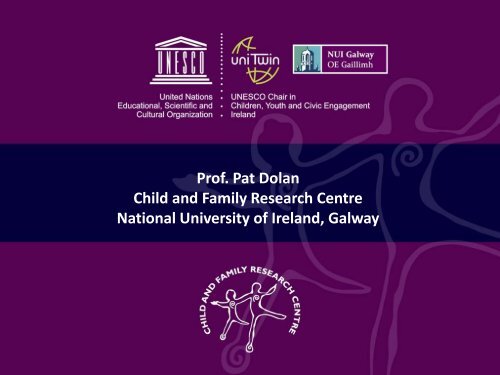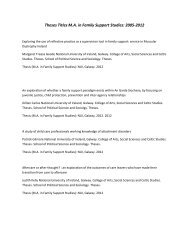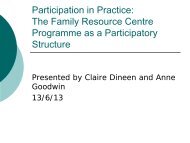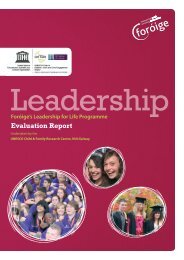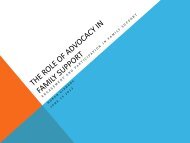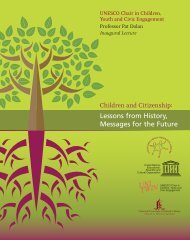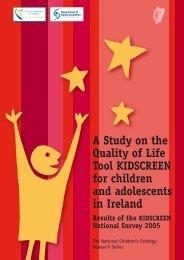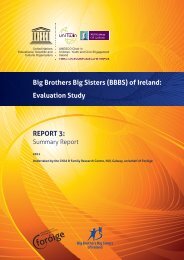Youth - UNESCO Child and Family Research Centre
Youth - UNESCO Child and Family Research Centre
Youth - UNESCO Child and Family Research Centre
- No tags were found...
Create successful ePaper yourself
Turn your PDF publications into a flip-book with our unique Google optimized e-Paper software.
Prof. Pat Dolan<strong>Child</strong> <strong>and</strong> <strong>Family</strong> <strong>Research</strong> <strong>Centre</strong>National University of Irel<strong>and</strong>, Galway
In this Presentation….1. Explore <strong>Youth</strong> Civic Engagement in Irel<strong>and</strong> Historical(brief <strong>and</strong> light touch!)2. Defining Describing <strong>and</strong> Valuing in Civic Engagement3. Some theoretical Underpinnings:(Social Support <strong>and</strong> Resilience)4. Models - What Young people <strong>and</strong> those who workwith them can do5. What Government can <strong>and</strong> should do!
Starting Point• There is the prospect that with support, childrencan <strong>and</strong> do overcome adversity• Core to the mission of Irel<strong>and</strong>, <strong>UNESCO</strong>, as well asthe wider United Nations family• Recognise <strong>Youth</strong> as Strength <strong>and</strong> as a resource -their civic activation gives this expression• Parent rear young people for themselves as familiesbut also for the benefit of community <strong>and</strong> civicsociety
Irish Historical Context on parenting• Primarily Catholic - Large <strong>Family</strong>• Close Near by Ties in Rural <strong>and</strong> UrbanContexts• <strong>Child</strong> to Adulthood roles <strong>and</strong> responsibilitiesShort to long trousers!• Now a major change in Irish Demographics<strong>Youth</strong> <strong>and</strong> CitizenshipSo A massive learning curve <strong>and</strong> change inIrel<strong>and</strong>!
Early recognition of <strong>Child</strong>ren/<strong>Youth</strong> asValued Citizens by Pioneering Women ofthe Irish State“The Countess” et al!“<strong>Child</strong>ren’s Patriot Treat”Assembled 30,000 children in Dublin 1900 (Dolan 2010)
Lessons From the Past –<strong>Youth</strong> as Civic Activists!Charles Dickens (1812 – 1870)1. Young Pip!2. The Urania Project3. The Ragged Schools• Led by <strong>Child</strong>ren <strong>and</strong> <strong>Youth</strong> Participants• Early Mentoring(Hartley, 2008)
Connecting Civic Engagement• Valuing Young People today - not just into future• <strong>Child</strong>ren’s proven capacity to be civically active incommunities• Examples: Tsunami - 9/11• Should not take extreme events to see this• So by being supportive to others young peoplebenefit themselves,• This is particularly the case in respect ofDisadvantaged <strong>Youth</strong>• Not Seeing youth as MAD BAD or SAD!!
Why Civic Engagement of <strong>Youth</strong> is Critical?For <strong>Youth</strong> & FamiliesBetter outcomes for childrenPreventing ProblemsFor CommunitiesEffective <strong>Family</strong> FunctioningHealthy CommunitiesFor SocietyPromoting Social InclusionEffective Use of ResourcesProductive, well- educated workforceReduction of inequalitiesPromoting Active CitizenshipDeveloping Human <strong>and</strong> Social Capital
The Parenting of <strong>Youth</strong>All passed on as „social currency‟ResponsibilityGive physical careGive affectionGive positive regardProvide emotional securitySet boundariesAllow room to developTeach social behaviourHelp develop skillsHelp cognitive developmentFacilitate social activityTaskFeeding, shelter, rest, health, protectionOvert physical <strong>and</strong> verbal warmth <strong>and</strong> comfortGive approval, sensitivity to signals,responsivenessConsistent <strong>and</strong> predictable warmth, sensitivity <strong>and</strong>comfortClear statements on what is acceptable, goodsupervisionProvide <strong>and</strong> allow challenges within the child’scapabilityModel reliability, reasonableness, <strong>and</strong>assertivenessEncourage learning <strong>and</strong> exploration, beresponsive in playReading, constructive play, monitor schoolingFacilitate peer contact <strong>and</strong> provide newexperiences
UNICEF/<strong>UNESCO</strong> WELLBEING INDICATORS FOR YOUTH• Material wellbeing• Health <strong>and</strong> Safety• Educational Well-being• <strong>Family</strong> <strong>and</strong> Peer Relationships• Behaviours <strong>and</strong> Risks• Subjective well-being(UNICEF, 2009)
Types of Civic Engagement for <strong>Youth</strong>:Political - Social Justice – Cause BasedSocial – Altruism - Need Based<strong>Youth</strong> Civic Engagement in Home“Young Carers”<strong>Youth</strong> Civic Engagement in School“Peer Educators or Mentors”<strong>Youth</strong> Civic Engagement in CommunityClub or Social Project Leaders
Key Descriptors of <strong>Youth</strong> Civic EngagementBelonging•A positive relationshipWith a Caring Adult•An Inclusive EnvironmentMastery•Engagement in Learning•Opportunity for MasteryIndependence•Opportunity for•Self Determination <strong>and</strong>To see oneself asA future active participantGenerosity•Opportunity to offerService to others –AltruismAdapted from the 4- H programmes Prepared by Cathann A. Kress,Director, <strong>Youth</strong> Development, National 4-H Headquarters, CSREES,USDA. September 2004.
The Ingredient of Self-compassion• Issues of Social Presentation <strong>and</strong> Emotional Literacy(UNGER 2006)Buddha -“All that we are is the result of what we havethought”.
Better WellbeingDolan in PressResponsive Social SupportStrong ResilienceSelf -CompassionSocial & Political Civic EngagementAll <strong>Youth</strong> with Normative <strong>and</strong> Non-Normative Development
Types of Civic EngagementA current Example from Zambia(McArdle in paper)
Civic Economic Social Political CulturalSchool: Male activities: Community: <strong>Youth</strong>: School:A member of:<strong>Child</strong>ren’s council orstudent councilPrefect or monitor<strong>Child</strong>ren’ Rights ClubDebate ClubStreet vendingFarming <strong>and</strong>labouring.Crushing stonePeer groupsCaring for othersNational Independence Daycelebrations<strong>Youth</strong>pressuregroupsCulture clubDrama clubPoetry clubDancing singingArts clubCommunity:Member of youthactivities, clubs,scouts/girl guides, redcross, <strong>Youth</strong> Alive,Female activitiesin public:Markets, maids,farming <strong>and</strong>prostitutionSport/school activities:Football, netball, volleyball,basketball, baseball, athletics,rugby, tennis <strong>and</strong> swimmingMainlyAdults:Community:InitiationceremoniesLanguageTraditional valuesNational <strong>Youth</strong>Association<strong>Child</strong>ren‟s pressbureauSport for ActionFemale activitiesin the home:Household chores,caring for siblings.Home-based games: Hide<strong>and</strong> seek, snakes <strong>and</strong> ladders,Icienga, Nsolo,, sigi, paddapadda <strong>and</strong> riding bicyclesAdvocacy bychurchesSpirituality/faith:Churches ofdifferent faiths<strong>Youth</strong> choirs.Salvation ArmyRural developmentprogrammesSchool:Anti-AIDs club, Road <strong>and</strong>transport agency – road safety.Science club, self-evaluationclubEvangelism,outreachScripture Unions,YWCA
Social Support TheoryAnd the Civic Engagement ofYoung People via Leadership
TEA as Types of Social Support for Young PeopleTangibleBalance <strong>and</strong>BuoyancyEmotionalAdviceDolan, 2008
CARDS as Qualities of Social Support <strong>and</strong> Attainablefor Young People through <strong>Youth</strong> Leadership <strong>and</strong> CEProgrammesCloseAdmonishPositivelyReciprocalDurableDolan. 2008
CARDS as Qualities of Social Support <strong>and</strong> Attainablefor Young People through <strong>Youth</strong> Leadership <strong>and</strong> CEProgrammesCloseRelationships fromInvolvementIn community programmesAdmonishPositivelyConsultationon Policies that affectYoung PeopleReciprocalScouts becomingScout LeadersDurablePersisting withSocial ProjectsOr Social JusticeCausesDolan. 2008
Resilience v Despair<strong>and</strong> Familial Civic Engagement• Resilient in Hiding• Despair post Sister’s Death in Captivity
Defining Social Support“Responsive acts of assistance betweenhuman beings” Tracy <strong>and</strong> Whittaker(1994)Its Proven Buffer to Stress role/One ofthe few proven areas of Social Science(From medical research)
Key issues in Social Support for <strong>Youth</strong><strong>and</strong> for their Civic EngagementInformal Support(Ghate <strong>and</strong> Hazel 2002)Hidden Support as most effective (Cutrona et al2010)Levitt’s Convoy Model of Support (Levitt, 1998)
UNICEF Indicator of Wellbeing in<strong>Youth</strong>Social Support FactorCivic EngagementActivityMaterial well-being Concrete Support EnvironmentalCommunity Clean upSchemesHealth <strong>and</strong> SafetyConcrete <strong>and</strong> AdviceSupport<strong>Youth</strong> participation inpersonal/communitySafety projectsEducational Well-beingAdvice/ Esteem Supportfrom Durable RelationsCommunal In-SchoolEducational & SocialAssignments<strong>Family</strong> <strong>and</strong> Peer RelationshipsBehaviours <strong>and</strong> RisksCloseness <strong>and</strong> Reciprocity ofSupportMitigated by a PositiveSocial Network membershipIntergenerationalProjectsPeer Mentoring ProjectsSubjective well-being Perceived Social Support Activities where youthfundraise for others inneed
The Power of Perception in Social SupportA key Ingredient in how we perceive <strong>Youth</strong> ascontributors to Society?
The Power of Perception in Social SupportA key Ingredient in how we perceive <strong>Youth</strong> ascontributors to Society?
Outside of Parents <strong>and</strong> <strong>Family</strong>-the Role of Friendships in adolescence <strong>and</strong> asInfluence in CE(Webster-Stratton 2007)
For Teenage ParentsHidden <strong>and</strong> Durable SupportParticularly from ParentsPerceived Support –Key how they viewed help on offer.Convoyed NetworksEnabling them to Access Education/Services(Riordan 2005)Social Provisions Scale (Dolan, Cutrona <strong>and</strong> Russell 2010)Measures Social Support in <strong>Child</strong>ren/Parentsfor Quantity <strong>and</strong> Quality of support
What I have learned• From my own <strong>Youth</strong>• work experience <strong>and</strong> from my research• For those in adversity, civic engagement canlead to significant improvement - <strong>and</strong> helprebuild key relationships• The Case of John <strong>and</strong> Hillwalking!!!
Respect for <strong>Child</strong>ren <strong>and</strong> <strong>Youth</strong>• Underpinning Rights as part of Civic Engagement• Social Justice in <strong>Child</strong>ren <strong>and</strong> <strong>Youth</strong> (Honneth1995) – “Recognition”• Hypothesis: If children <strong>and</strong> youth are valued,they will be civically engaged (political <strong>and</strong>social)
<strong>Youth</strong> Cafés as a Model/Project forSocial Civic Engagement of <strong>Youth</strong>• <strong>Youth</strong> Led Community Service – with full <strong>Youth</strong>Governance• Universal Support programme for youth drugs<strong>and</strong> alcohol free• Targeted Support Programmes e.g. Gay <strong>and</strong>Lesbian <strong>Youth</strong>• Social Civic Engagement e.g. base for support tohomeless adults “soup runs”See OMCYA.ie
<strong>Youth</strong> Parliament as a Model/Project forPolitical Civic Engagement of <strong>Youth</strong>• <strong>Youth</strong> Participation – voice of youth on policy• Dail no Nog operates as a parliament• Venue to express concerns on issues that affectyouth e.g forthcoming Irish referendum on therights of children <strong>and</strong> youth• Town planning• Service for youth planning consultationSee OMCYA.ie
Resilience“Doing Better than expected”“Bouncing Back”“overcoming the Odds” (Masten, 2004)How can thisbe builtthrough CivicEngagement?Weighing Scale - Protective Factorsoutweighing Risk Factors (Gilligan, 2009)
Civic Engagement of <strong>Youth</strong> as CompensatoryCan also FosterSelf-Compassion& RestorationHow can this bebuilt through CivicEngagement?
Civic Engagement & <strong>Child</strong>/<strong>Youth</strong> RightsInternationally• Bound by issues such as religion, class <strong>and</strong> genderExamples of Issues in:- Republic of Irel<strong>and</strong>- Countries in transition- Sub-Saharan Countries- Reciprocal learning- Need for Cultural Competence (Husain, 2006)
In Conclusion….• So Where does this leave us..
Development & Quality Testing of <strong>Youth</strong> Civic EngagementActivitiesInternational<strong>Youth</strong>LeadershipProgrammesCivicEngagementModels – PostConflict CountriesReflectivePracticeMethodsProductsQualityAssuredPackagesPracticeProgrammesAssesmentsTool KitsProgramme &Policy AlertsTargeted Funding Sources?Key Partners / Contributors?
For C & Y (universal)For C & YIn AdversityEnlistedSocial SupportEnabledResilienceCivic EngagementActivationRights <strong>and</strong> Respect for<strong>Child</strong>ren/<strong>Youth</strong>
Instilling predictable hope in others that they cancontinue to grow <strong>and</strong> will overcome the odds- Agenda for <strong>Youth</strong> <strong>and</strong> CE- (But hidden)


